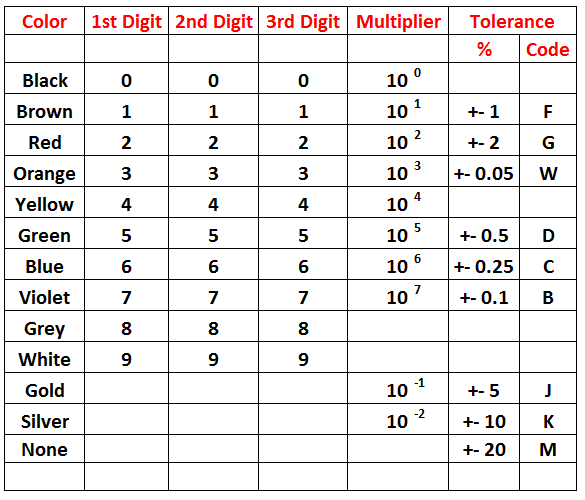Fundamental of Resistors and their characteristics
Introduction To Resistors
A package of material which exhibits a certain resistance made up into a single unit is called a resistor. Different res. having the same resistance value my be different in physical size and construction depending on its power and applications.
When current flows through a res., it causes the conductor to become heated up. CFR that are needed to carry large current must be physically big enough so that the heat can be radiated quickly to the surrounding air or else it may melt or burn. Therefore, the study of the power derating of the res. is important.
Carbon film res. is still used in the market. Chip res. is becoming more common nowadays replacing carbon film res..
Values and Tolerance
Unit of resistance is ohms, the symbol for ohm is an omega. Res. values are normally shown using colored bands. Each color represents a number as shown in the table below.

Color code of 5 color bands
- The first band gives the first digit.
- The second band gives the second digit.
- The third band gives the third digit.
- The fourth band indicates the number of zeros.
- The fifth band is used to shows the tolerance (precision) of the res. Tolerance of res.(fourth band of color code).Tolerance is the precision of the res. and it is given as a percentage. For example a 1000 ohm res. with a tolerance of ±10% will have a value within 10% of 1000, between 1000 - 100 = 900 and 1000 + 100 = 1100 (100 is 10% of 1000).
Example
1st 2nd 3rd 4th 5th Color
Brown Green Yellow Orange Brown
(1) (5) (4) (1000) (±1 %)
This means that the value of the res. is 154k ohm with a tolerance of 1%.
Color code of 4 color bands
- The first band gives the first digit.
- The second band gives the second digit.
- The third band indicates the number of zeros.
- The fourth band is used to shows the tolerance (precision) of the resistor.
Example
1st 2nd 3rd Color
Brown Green Orange Gold
(1) (5) (1000) (±5 %)
This means that the value of the res. is 15k ohm with a tolerance of 5%.
Power Ratings
Electrical energy is converted to heat when current flows through a res. Usually the effect is negligible, but if the resistance is low (or the voltage across the res. high) a large current may pass making the res. become noticeably warm. The res. must be able to withstand the heating effect and res. have power ratings to show this.
The power, P, developed in a res. is given by: P = I² × R or
P = V² / R where:
P = power developed in the res. in watts
I = current through the res. in amps
R = resistance of the res. in ohms
V = voltage across the res. in volts
Examples:
A 390 res. with 12V across it, needs a power rating P = V²/R = 12²/390 = 0.37W. In this case a standard 0.5W res. would be suitable.
A 27 res. with 9V across it, needs a power rating P = V²/R = 9²/27 = 3W. A high power res. with a rating of 5W would be suitable.
Recommendation when using resistors
a) Keep the rated power and ambient temperature within the specified derating curve. When positioning and mounting Carbon Film Resistors, make allowance for the effect of heat generated through close contact between the res. and neighboring components and for the temperature rise of adjacent heat-generating components.
b) If a transient load (heavy load in a short time) like a pulse is expected to be applied, check and evaluate the operations of the res. when installed in your products before use. When applying pulses to the res., keep the pulse peak within the rated voltage.
Back To Resistors Home Page



New! Comments
Have your say about what you just read! Leave us a comment in the box below.